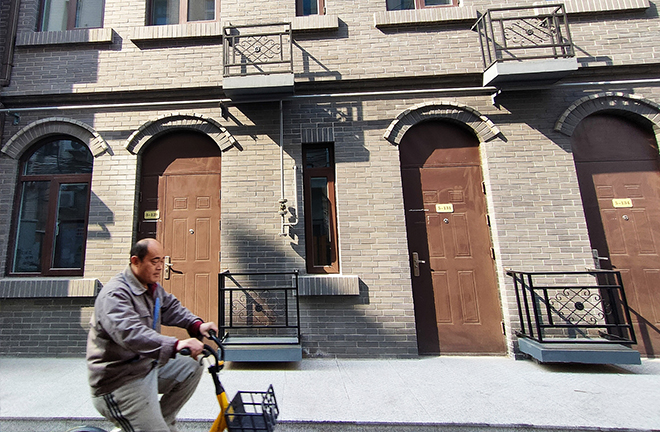Comprehensive urban renewal drives social integration

The urban renewal project preserving its historical features in Heping District, Tianjin, Feb. 27 Photo:CFP
In the new era, urban renewal in China has entered a comprehensive phase that fully reflects its people-centered nature. In order to promote social integration while undertaking comprehensive urban renewal, it is necessary to both highlight the economic value in urban transformation, maintain the human-centered attributes and socio-cultural values embedded in it, and to comprehensively enhance the inclusiveness, the degree of fusion, and the integration capabilities of cities by extending the social functions of urban space and reshaping urban social networks.
Putting the people first
China’s comprehensive urban renewal has gradually entered a new development stage focusing on revitalizing the existing space and realizing its incremental value, providing a broad perspective and lasting momentum for the sustainable development of the natural environment, physical space, and public cultural space. While focusing on spatial transformation as a whole, comprehensive renewal should also focus on creating a more inclusive, diversified and equitable new space for urban living. Exploring the iterative upgrading of comprehensive urban renewal in terms of transformation methods, development goals and renewal concepts is of great significance to enhancing people’s well-being and improving their quality of life.
First, the comprehensive nature of urban renewal should be understood, and the shift of transformation methods realized. In recent years, the connotations and extensions of urban renewal in China have developed in the direction of comprehensiveness and wholeness, gradually moving from simple physical space demolition and reconstruction to industrial transformation and functional adjustments, spatial governance system improvements, and humanistic spirit reconstruction.
Second, it is necessary to understand the inclusiveness of urban renewal and ensure sufficient motivation for the transformation of its development. Effective urban renewal has consistently relied on its genuine concern for humanity to unleash the innate potential of the city, enhance its spatial inclusiveness, and foster social integration. This is central to any holistic approach to urban renewal.
Third, the people-centered nature of urban renewal should be grasped and the growing needs of the people for a better life continually met. Rejuvenating old urban areas must focus on the human-scale spatial structure and prioritize a people-centered approach to social governance. Renewal efforts should equally address economic, social, material, and cultural aspects, while also meeting the increasing demand for high-quality public cultural spaces and services to enhance people’s quality of life.
Integrating social relationships
According to the theory of socio-spatial dialectic, urban renewal spaces are often characterized by socio-cultural attributes that can both regulate and reshape social relationships. To effectively enhance the integration of social relationships through comprehensive urban renewal, it is important to consider not only the material aspects of urban space, but also interactive and cultural-ethical elements.
First, it is necessary to extend the social and cultural functions of space and preserve the urban “memory.” Comprehensive renewal involves utilizing the history and accumulated memory of urban spaces to improve their social and cultural functions. By extending and revitalizing these functions, the spaces can better serve the community. When renovating historic districts, we should not only fully explore the spatial potential and cultural value of the buildings, but also transform the previously closed districts into open and shared public spaces. This will awaken the cultural memory of urban space in the historical and temporal dimensions. Meanwhile, it is crucial to reintroduce contemporary social life into the old buildings that have lost some of their functions while maintaining the original urban pattern and street texture. This will help revitalize the historic areas and restore their value and liveliness.
Second, it is vital to build a spatial experience of coexistence and enhance cultural identity. From the viewpoint of co-temporality, culture has the role of coordinating and organizing different groups. Urban space is not only a physical space, but also a social space of interactive human activities.
Third, the orientation function of culture should be fully leveraged to reshape social relations. Cultural spaces transformed by comprehensive renewal are not only regional communities, but more importantly, cultural communities which can express the spiritual character of the city through cultural power and exhibit harmonious, stable, and inclusive urban patterns.
Innovating governance
It is urgent to establish a synergistic development mechanism between urban renewal and social governance to realize the joint construction and governance of multiple entities, and to enhance social integration through governance innovation.
First, the governance entities of diversified co-construction should be supported. Involving multiple entities in urban renewal projects can not only reduce the socioeconomic costs of urban renewal, but also keep the dynamic balance of order and vitality in the city and create a tightly connected social network.
Second, the process of cooperative and shared governance should be improved. On one hand, the mutual trust and interdependence of the government and the public should be strengthened. On the other hand, the public and related social organizations should not only participate in urban planning, but also in the management and regulation of urban renewal affairs. This will help them transition from mere participation in planning to also participation in governance.
In the end, this will result in governance fruits that can be shared by society. In terms of governance outcomes, the inclusiveness of comprehensive renewal is mainly reflected in allowing people to share equal urban rights, open public spaces, and quality public services.
Liu Mingqiu is a professor from the School of Marxism at Donghua University.
Edited by ZHAO YUAN
